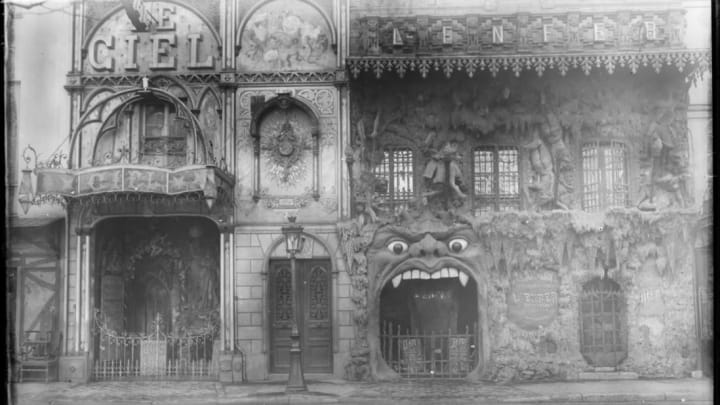The theme restaurants of today's Times Square owe a debt to the cabarets of 19th-century Paris, particularly a trio of death-obsessed locations in the red light district of Montmartre. These nightclubs featured over-the-top decorations and elaborately attired waiters, plus unusual performances with enthralling illusions.
The Cabaret du Néant ("Cabaret of Nothingness"), which opened in 1892, was perhaps the most famous. The entrance was draped in black mourning crepe with white trimming, and instead of a bouncer, a pallbearer dressed in a black cape and top hat stood outside. The 1899 book Bohemian Paris of To-day by W.C. Morrow and Édouard Cucuel, which called it a "grisly caricature of eternal nothingness," described the inside this way:
"The chamber was dimly lighted with wax tapers, and a large chandelier intricately devised of human skulls and arms, with funeral candles held in their large fleshless fingers, gave its small iota of light. Large, heavy, wooden coffins, resting on biers, were ranged about the room in an order suggesting the recent happening of a frightful catastrophe. The walls were decorated with skulls and bones, skeletons in grotesque attitudes, battle pictures, and guillotines in action."
As Morrow's group took their places, a half-dozen monotone voices droned: "Enter, mortals of this sinful world, enter into the mists and shadows of eternity ... and may God have mercy on your souls!" No detail was ignored: bells tolled, a funeral march played, and the place even smelled like a charnel house, according to Morrow. The waiters were also dressed like pallbearers, and addressed the drinkers as macchabées—French slang for a corpse, particularly those found drowned in the Seine. A drink order was relayed to the bar as "One microbe of Asiatic cholera from the last corpse, one leg of a lively cancer, and one sample of our consumption germ!"
While seating at the candlelit coffins and enjoying their poisons, guests were treated to a "discourse on death," which ended with a variety of bloody paintings that seemed to glow and then reduce their subjects (soldiers on a battlefield, an execution by guillotine) to skeletons. But these optical illusions were just a taste of the delights that awaited them in a second room. There, seated on small black caskets, they watched as a member of the audience stepped into an illuminated coffin at the front of the room and seemed to be transformed into bones right in front of their eyes.
This was actually a famous Victorian illusion known as "Pepper's Ghost," and was accomplished by shrouding the skeleton-to-be in fabric, fitting him or her precisely into the coffin, and using a series of lights and glass plates to reflect the image of a skeleton from one side of the room onto the person in the coffin. Named for 18th-century British scientist John Henry Pepper, who developed the trick, it is still used at theme parks, and was the technique behind Michael Jackson's appearance at the 2014 Billboard Awards.
Hardy souls looking for more ghoulish delights could also visit the Cabaret de L'Enfer ("The Cabaret of Hell"), whose entrance took the form of an enormous, fanged mouth. The doorman greeted guests by shouting "Enter and be damned!" while inside, molten streams of gold and silver decorated walls that would sometimes erupt in flames and thunder. When Morrow visited, a waiter dressed as a devil relayed his group's order of three black coffees with cognac as "Three seething bumpers of molten sins, with a dash of brimstone intensifier!" The drinks arrived glowing with a phosphorescent light, while musicians played selections from "Faust."
Just next door was Cabaret du Ciel ("The Cabaret of the Sky," sometimes referred to as "The Cabaret of Heaven"), with gilded gates, shining blue lights, and a crew of angels dressed in gauzy robes and sandals. This time, drinks were referred to as "sparkling draughts of heaven's own brew," but the disheveled angels don't seem to have been as effective as the denizens of Montmartre dressed as devils. Still, Morrow reported that a ceremony where St. Peter blessed the assembled with holy water was enjoyed by all.
Sadly, none of these cabarets survived World War II—which may have rendered their offerings a little tasteless by comparison. But a selection of their images and ephemera still survive (and periodically resurface on the internet), some of which can be seen below.
